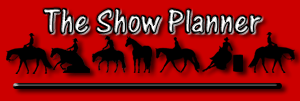 |
|
Show Horse Promotions Mary Murray
|
Tying Up in HorsesArticle is printed with permission from Stephanie J. Valberg, D.V.M., Ph.D. Tying up, the most common muscle problem in horses has also been called azoturia, paralytic myoglobinuria and chronic exertional rhabdomyolysis. Clinical signs include sweating, stiffness and reluctance to move forward. Tying up is not a single disease, but a collection of clinical signs that may have different causes in different in each horse. Specific causes for tying up have recently been identified and more are on the research horizon. Sporadic tying up is seen in horses that have always exercised normally, but suddenly exhibit signs of tying up. It can be due to; exercise in excess of training level: exhaustive exercise: respiratory infections: lack of dietary selenium/vitamin E or lack of dietary electrolytes and minerals. These horses usually recover with rest, adjustment of the diet treatment, gradual return to exercise and go on to perform successfully. Other horses have a chronic form of tying up from a very young age with continual problems even when exercised lightly. This syndrome has been described in many breeds and can have different causes. A thorough investigation into their cause of tying up is necessary and requires the operation of the horse owner/trainer, their veterinarian and often consultation with a veterinary medical specialist. A "workup" for tying up involves evaluation of urine and serum electrolytes and minerals, measurement of muscle enzymes released into the serum pre and 4 hours post exercise and evaluation of muscle biopsies. One cause of chronic ER in Quarter Horse related breeds, Draft horses and Warmbloods is a metabolic defect called polysaccharide storage myopathy (PSSM). This is the most common cause of ER in Quarter Horse- and Draft related breeds and appears to be inherited. Horses with PSSM store an excess of glycogen in their muscle. Muscle sections stained with periodic acid Schiff's stain show that a proportion of the glycogen is stored in an abnormal fashion and is not available for energy production. Horses with PSSM have a greater sensitivity to insulin, which likely increases transport of sugar into skeletal muscle after a carbohydrate meal. The exact link to muscle necrosis is not clear but may be related to disruption of the balance of energy metabolism by excessive muscle glucose 6 phosphate. The lactic acid level in these horses, when they tied up is actually very low. Treatment of horses with polysaccharide storage myopathy involves supplying them with feed that maintains low blood sugar and low blood insulin concentrations (no grain and a fat source such as rice bran) combined with regular daily exercise. Stall rest or irregular exercise may cause another episode of tying up. Over 90% of horses will improve dramatically and return to full athletic performance by following the recommended changes in diet and exercise. Other breeds of horses may tie up for completely different reasons. Current research indicates another cause of tying up exists in Arabian, Standardbred and Thoroughbred horses that is related to an abnormality in the way the muscle cells regulate intracellular calcium during a muscle contraction and may involve a genetic predisposition. This form of tying up, called recurrent exertional rhabdomyolysis (RER), is not related to dietary calcium intake. Five percent of racing Thoroughbreds, especially young nervous fillies, are affected. Energy metabolism and glycogen storage appears to be normal in RER horses. Muscle stiffness usually occurs when exercise and excitement combine such as at a horse show, after a steeplechase or when being held back to a lower pace than they desire. In Standardbreds, tying up often occurs after 15 min of jogging. The approach to treating these horses is to minimize excitement and stress and substitute part of the grain ration with fat supplements containing rice bran. Research continues in order to develop the best diagnostic tests and treatments for the variety of forms of tying up in these breeds
© 2000 - 2010 Show Horse Promotions The Show Horse Promotions web site is an informational web site, this information is subject to change without notice. Any use of, or actions taken based upon any of the information contained on this web site is done entirely at your own risk. Show Horse Promotions expressly prohibit you from republishing or redistributing this content without first receiving our written consent. By using this site, you agree not to hold us liable for any errors or delays in this content, or for any actions that you take in reliance thereon. This site contains links to other Internet sites. These links are not endorsements by us of any products or services in those sites, and we have not endorsed or approved any information in those sites. |
|
||||||||
